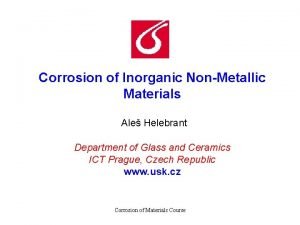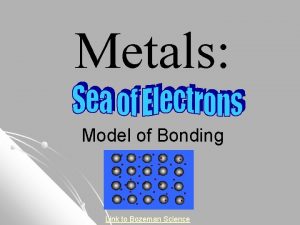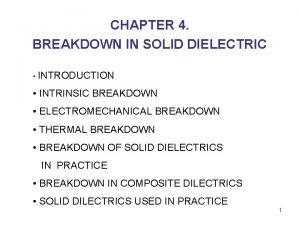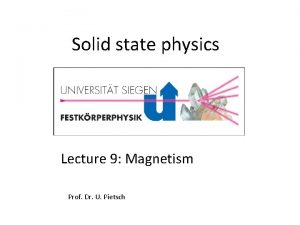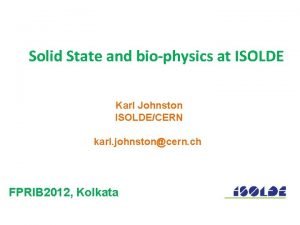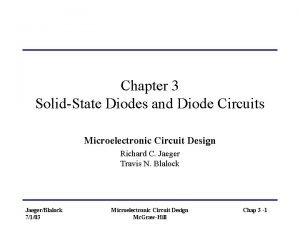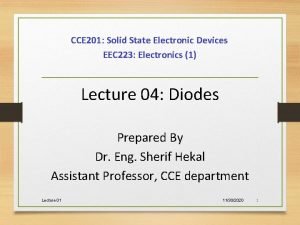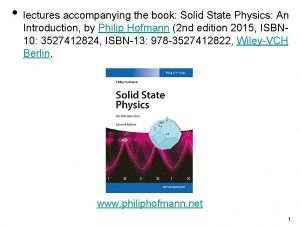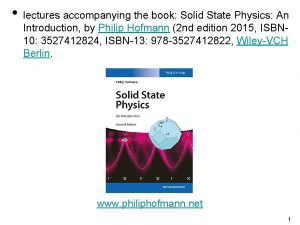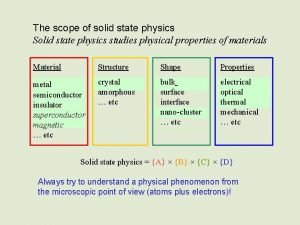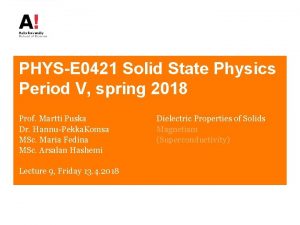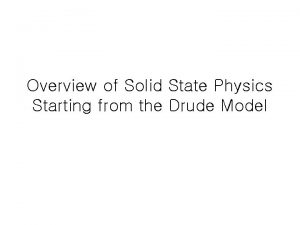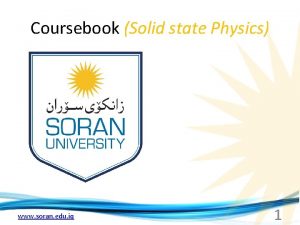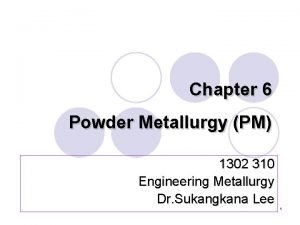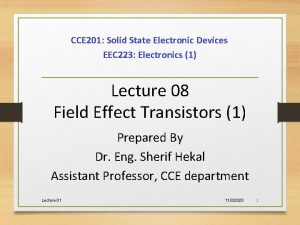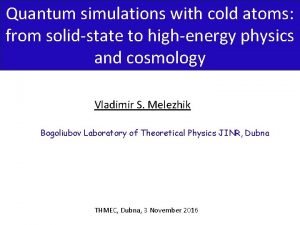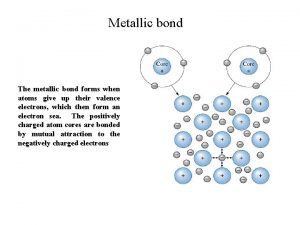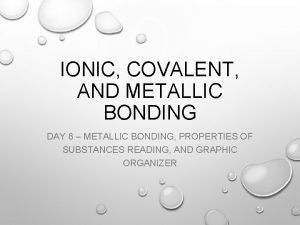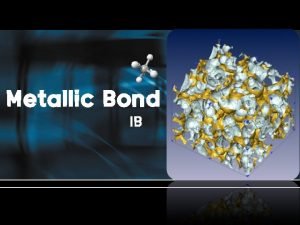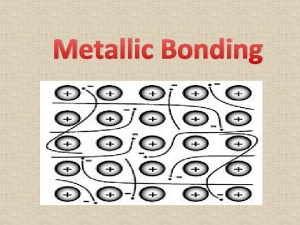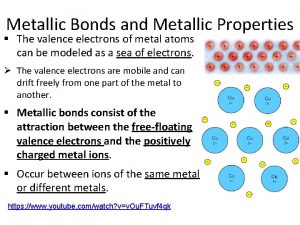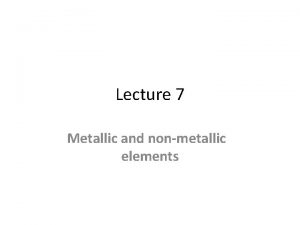Materials science I Metallic materials Solid state Pure









































- Slides: 41

Materials science I - Metallic materials Solid state Pure materials Alloys atomic structure atomic arrangement microstructure macrostructure - components - phases - systems - homogeneous - heterogeneous

Materials science I - Metallic materials Solid state Atomic structure – forces between atoms are strong, changes of volume and shape needed high energy. Bonding of atoms in metallic materials is „METALLIC“ electrons on last orbital of atoms are released, atoms becomes positive ions. Free electrons are sheared as the „cloud“ or „sea“ with other ions. • Metallic bond is equally strong in all directions • Compounds with metallic bonds form a regular lattice structures. • The free electrons can move – materials with metallic bonds are electrical conductive

Materials science I - Metallic materials Atomic structures: Crystalline - regular atom distribution form the lattice (long distance regularity) Amorphous - irregular atom distribution (short distance regularity) Metallic metals are mostly formed in 3 lattices: FCC - face centred cubic K 8 BCC - body centred cubic K 12 HCP - hexagonal close - packed H 12


Materials science I - Metallic materials Microstructure: Monocrystalline: whole bulk has the same orientation of lattice Ideal monocrystalline is free of the lattice imperfections Point faults (vacancies, interstitial atoms, substitution atoms) Line faults (dislocations – edge, screw and general) Areic faults (stacking faults, free surfaces, grain boundaries) Volume faults (coherent particles)


Polycrystalline: in bulk of material exists areas or volumes with different lattice orientation called grains. Places, where grains are connected are grain boundaries - narrow areas (about 5 atoms) where the mismatch of connecting lattices are compensed by suitable distributed imperfections - atoms, vacancies and dislocations.

Materials science I - Metallic materials Microstructure: Small structure components visible only using the suitable type of microscope: atoms, dislocations, grain boundaries, secondary phase particles (precipitate), impurities, number of presented phases, their distribution, portion … In dimensions about nm and bigger Macrostructure: Visible by eye or with help of magnifying glass. Large structure components as big or dendritic grains (after casting, or some heat treatment), impurities, … In dimensions about tens of mm and bigger.

Materials science I - Metallic materials Pure metals: Ideal pure metals are composed only with the same atoms. Real material content impurities becoming from their manufacturing. Pure metals are marked as 99, 9 %. Very pure materials content 99, 999 % of matrix atoms Alloys: Are solid state multicomponent systems containing except atoms of fundamental metal the added alloying elements and elements of impurities more.

Materials science I - Metallic materials Alloys: Terms: Components: alloying elements Phase : homogeneous portion of a system that has uniform physical and chemical characteristics e. g. polymorphic forms in solid state Single phase systems are termed homogeneous e. g. melts, pure metals Multiphase (two or more phases) are heterogeneous. Most of the metallic alloys are heterogeneous systems.

Materials science I - Metallic materials Solubility is a maximum concentration of solute atoms in solid solution. Solid solution is formed in host material latice, where the atoms of impurities are solved. Atoms, which are smaller than atoms of the host material forms interstitial solid solution. Atoms fill the volumes between atoms of the host material lattice (carbon in iron). Atoms with close diameter (difference les 15 %) replaces some atoms in host materials. This type of solid solution is substitutional (cooper and nickel).

Materials science I - Metallic materials Solid solutions Solubility unlimited the atoms are mixed in whole range of concentrations (from 0 to 100 %) exist some maximum concentration of atoms which can be solved in host material. Generally it is connected with temperature. Interstitial solid solutions have in every cases limited solubility (max 10 %) due to limited free interstitial volume in lattice, where the solute atoms can be placed.

Materials science I - Metallic materials Equilibrium between phases in the system is described with the Gibbs free energy G = H – TS. The temperature and pressure play role. Every change in system is described by change of free energy ΔG The system is in equilibrium state, when the free energy reaches minimum value. This state is termed stable. Each change in system may lead to changes in equilibrium. In real alloys, in solid state, if the changes needs more time, the equilibrium state is not reached. System will decrease free energy during the time. The equilibrium is termed metastable.

Materials science I - Metallic materials Gibbs phase rule Is the criterion of number of phases, which will coexist in equilibrium conditions in the system P + F = C + N P - number of present phases F - number of degrees of freedom (temperature, pressure, composition etc. ) C - number of components (elements or stable compound of phase diagrams) N - number of noncompositional variables (temperature, pressure)

Materials science I - Metallic materials Gibbs phase rule We search possible number of freedom F = C + N - P Generally N = 2 (if the temperature and pressure play role) (equilibrium in system with gaseous, liquid and solid state) When we consider no pressure influence, the N = 1 (equilibrium phase diagrams of alloys) For pure metal is C = 1 exist only one temperature, when coexist melt and solid state – solidification (crystallization) proceed at constant temperature

Materials science I - Metallic materials temperature Cooling curves time pure metal time alloy

Materials science I - Metallic materials Diffusion Phenomenon of material transport by atomic motion – in solid state only one possible. Phase changes in the solid state systems are mostly possible due to diffusion. In pure materials the atoms changes their positions, there are no changes in chemical composition - self diffusion. In real alloy, the moving of atoms lead to chemical content changes. This phenomenon is termed as interdiffusion or impurity diffusion.

Materials science I - Metallic materials Diffusion Difusion couple Cu - Ni

Materials science I - Metallic materials Mechanisms of diffusion For atom moving into the lattice, there must be an empty place, and the atom must break the attraction forces their neighbours. Vacancy mechanism – moving own or substitutional atoms to position of existing vacancies. Interstitial diffusion – moving interstitial atoms into neighbour interstitionals positions in lattice. The possible but low frequented are exchange and ring mechanisms.

Materials science I - Metallic materials Diffusion The moving atoms from their positions is influenced by vibration in lattice. If the amplitude of vibrations reach the value when the barrier of atomic attraction forces is exceeded, the atom can change your position. The energy needed for amplitude increasing is called activation energy Qd. Diffusion rate of steady state diffusion is described by 1 st Fick’s law: J D C x D 0 - diffusion flux - diffusion coefficient - concentration - position - temperature independent diffusion constant

Materials science I - Metallic materials Diffusion The term is concentration gradient of concentration profile Driving force of the steady state diffusion is concentration gradient Nonsteady state diffusion The time t of the process is considered – 2 nd Fick’s law Solution is erf is the Gausian error function

Materials science I - Metallic materials Diffusion The depth of diffusion can be expressed as h ≈ (Dt)1/2 or from equation for middle quadratic distance of moving atoms Volume or bulk diffusions is relative slow process The diffusion is accelerated by lattice imperfections. The other diffusion paths are along dislocation, through the grain boundaries or along free external surfaces. Temperature accelerates diffusion but is not the driving force! increases diffusion coefficient, increase the atom vibration amplitude, increase the number of vacancies.

Materials science I - Metallic materials Solidification is process of changing atomic coupling. The liquid state of metal – melt transforms to a solid state. The system is driven to minimize the free energy. ΔG = GL - GS If the temperature decreases, the equilibrium between liquid and solid state is violate, and nuclei of solid state (phase) can rise.

Materials science I - Metallic materials Solidification Nucleation Consider formation of small spherical nucleus with radius r, is the surface energy of nucleus interface Surface free energy Critical nucleus size r* is the minimum size of nucleus, which is able further growth. ΔG* is the nucleation barier Volume free enrgy

Materials science I - Metallic materials Solidification Nucleation homogeneous – fluctuation of energy, spontaneously heterogeneous on existing surfaces Number of nuclei s is the number of available nucleation sites Rate of nucleation q is activation energy for diffusion

Materials science I - Metallic materials Solidification Nucleation homogeneous – fluctuation of energy, spontaneously heterogeneous on existing surfaces

Materials science I - Metallic materials Growth of new phase Planar – the growth is controlled by heat removing through the solid phase Dendritic – heat removing is possible through the solid phase and through the melt.

Materials science I - Metallic materials Casting structure Chill zone - first and fast cooled part of ingot - near to surface Columnar zone - area of long crystals Eqiuaxed zone – in the middle of the ingot

Materials science I - Metallic materials Eqilibrum phase diagram

Materials science I - Metallic materials Eqilibrum phase diagram Lever rule Weight of solid solution of composition m bm = Weight of liquid of composition q qb Ratio = bm/pb


Materials science I - Metallic materials Eqilibrum phase diagram Structure development

Materials science I - Metallic materials Eqilibrum phase diagram With eutectic reaction

Materials science I - Metallic materials Eqilibrum phase diagram Hypoeutectic alloy

Materials science I - Metallic materials Eqilibrum phase diagram Hypoeutectic alloy

Materials science I - Metallic materials Eqilibrum phase diagram Hypoeutectic alloy

Materials science I - Metallic materials Eqilibrum phase diagram eutectic alloy




 Applied science vs pure science
Applied science vs pure science Inorganic non metallic materials examples
Inorganic non metallic materials examples My favourite subject worksheet
My favourite subject worksheet Bozeman science metallic bonding
Bozeman science metallic bonding Amorphous vs crystalline
Amorphous vs crystalline Example of solid solution
Example of solid solution Covalent network solid vs molecular solid
Covalent network solid vs molecular solid Crystalline solid
Crystalline solid Crystalline solid
Crystalline solid Crystalline solid and amorphous solid
Crystalline solid and amorphous solid Anisotropic
Anisotropic When a solid completely penetrates another solid
When a solid completely penetrates another solid Interpenetration of surfaces
Interpenetration of surfaces What is sifting in separating mixtures
What is sifting in separating mixtures Applications of insulating materials
Applications of insulating materials Treeing and tracking breakdown
Treeing and tracking breakdown Solid physics
Solid physics Magnetism in solid state physics
Magnetism in solid state physics From solid state to biophysics
From solid state to biophysics Bacteria fermentation
Bacteria fermentation Voltage across diode
Voltage across diode Solid state electronic devices 7th solution chapter 4
Solid state electronic devices 7th solution chapter 4 Modulus of rigidity
Modulus of rigidity Philip hofmann solid state physics
Philip hofmann solid state physics Has
Has Solid
Solid Crystalline solid
Crystalline solid Solid state physics
Solid state physics Solid state physics
Solid state physics Drude model solid state physics
Drude model solid state physics Quantum number l meaning
Quantum number l meaning Www.soran.edu.iq
Www.soran.edu.iq Amorphous solid simple definition
Amorphous solid simple definition Powder metallurgy
Powder metallurgy Solid state electronic devices ppt
Solid state electronic devices ppt Block diagram of short wave diathermy
Block diagram of short wave diathermy Simulations for solid state physics
Simulations for solid state physics Solid state diode definition
Solid state diode definition Ozone solid state
Ozone solid state 4 quadrant operation of induction motor
4 quadrant operation of induction motor Solid state power amplifier definition
Solid state power amplifier definition Projektlabor tu berlin
Projektlabor tu berlin

